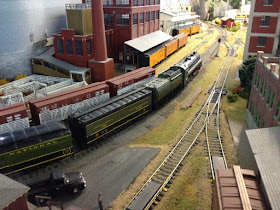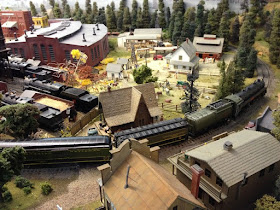Sunday, August 30, 2015
First Photos of Finished Bowser Canadian-Style SD40-2 Units
Thanks to Railroad Model Craftsman, there are photos of the first painted and detailed Bowser SD40-2 units.
The photos were taken at the National Train Show in Portland, OR.
Looking good!
Click here to pull up a series of posts about Bowser's new Canadian-style SD40-2, including the iconic Red Barn.
Saturday, August 22, 2015
Great Canadian Model Railroad: The St. Jacob's Junction
Now that the magnificent Aberfoyle Junction layout
is in St. Jacobs, Ontario, people who like model railroads are putting that
quaint southwestern Ontario town on their list of places to visit.
A trip to see that O scale layout—now known as the
St. Jacobs & Aberfoyle Junction—should
be on anyone’s bucket list. What many may not know is that there is another
great Canadian model railroad right across the street.
The Old Mill is home to a variety of speciality shops, and to the St. Jacob’s Junction, a
10 by 30 foot HO scale layout that pictures life in the area in the 1950s.
The layout is the brainchild of my friend Milo
Shantz, who died in 2009.
Milo, a long-time railfan, was inspired to create the
layout in 2005 after he was given an O scale and railroad memorabilia collection
belonging to his friend Jan Gleysteen.
Milo contacted some local modellers (Lance Russwurm, Harvey Sndyer, Dan Kirlin and local carpenter Don Stewart) to help turn his idea into reality.
I was able to visit the layout this summer; you can see the result of Milo’s vision in these photos.
What sets the layout apart from others is the
fantastic scratchbuilt buildings and other structures, along with the
realistic-looking scenes—including a compressed, but accurate, version of St.
Jacobs itself (including the Mill that houses the layout) and other
locally-known buildings.
Among the scenes visitors will find include old-style farming, a barn raising, a local Mennonite meeting house, gas stations, a coal dealer, and most of downtown St, Jacobs in the steam era. There is also a diorama of nearby Baden, built by Greg Shinnie.
On the other side of the room features Jan’s collection of O scale items and memorabilia. This includes rolling stock in his fictitious Peace River RR, the inspiration behind the Peace River shortline and the Peace River paper mill on my own CP Rail Manitoba & Minnestoa Sub.
The layout itself features three loops; only one half of each loop can be seen on the layout. (The other half is behind the layout, out of sight.)
Trains are
activated by a push button on the fascia, and run for about three minutes or so. Also notable is that the layout is
built at child-height, the better to be viewed by kids.
Since it is behind glass, photo taking is a bit tricky. But even with a bit of glare, I’m sure you’ll agree that the photos reveal that the St. Jacobs Junction is a great Canadian model railway.
More photos, including some from when the layout was
under construction, can be found here. The
layout’s website can be found here.
The layout is open during the Mill's regular operating hours. Admission is free.
Sunday, August 16, 2015
More of a Great Canadian Layout: The Carson & Cobourg
When I visited the Carson & Cobourg this summer, I took way more photos than I could use in a single post.
So here are some more, following up my earlier post about this Great Canadian Model Railroad.
Sunday, August 9, 2015
Great Canadian Model Railroad: The Carson and Cobourg
What
do you do when you have to dismantle your layout when you move to an apartment?
How
about starting another one with a friend in his basement?
That’s
what Vern Gibson and Marvin Fetch did seven years ago when Vern had to move.
The
two friends decided to combine their model trains and build a layout Marvin’s
house. Together the two Winnipeggers have created the Carson and Cobourg, named
for the street Marvin lives on and the street Vern used to live on.
The
HO scale layout fills a 19 by 19 room. And I mean it fills it—the layout is
crammed with interesting and intricate scenes from cityscapes to mountains to
rivers and industrial areas. Completing the overall scene are some well-placed backdrops.
The
layout, which is in the shape of a dog bone with loops at both ends, has a
mainline run of 70 feet. There are 63 turnouts, 26 spurs and 33 industries.
Buildings on the layout are a mix of kit, scratchbuilt and kitbashed.
DCC is used to operate the trains.
Set
in the transition era of the 1950s, it represents a freelance shortline with
strong ties to the CNR.
The
layout took Vern and Marvin two years to build.
The
two host monthly operating sessions with retired friends in the Manitoba Independent
Short Line Association—MISLA, for short.
“We
have fun,” says Marvin. “It was just two friends building a layout.”
Judging
from the photos, I think you’ll agree that these two friends have created a
Great Canadian Model Railroad.
I took a lot of photos during my visit; click here to view more from the Carson and Cobourg in the future.
Wednesday, August 5, 2015
Don't You Want To Live in a Model Railroad Town?
There are lots of railroad songs. But I wasn't aware of any about model railroads--until now.
My local radio station played Model Railroad Town by Allison Brown this morning. The lyrics go like this:
Don’t you want to live in a model railroad
town?
Waving at the train as it circles around
Time has stopped on the hands of the station
clock
And the only thing that’s moving is the train
Somebody brought it home from the church rummage
sale
Took it down the basement connected all the
rails
Painted white clouds on a bright blue sky
And the sun shines like a 60 watt light
From the old stone church to the library
From the lumberyard to the candy store
The world is as big as the ping-pong table
And the train only ever takes me back to my own
front door
From the old stone church to the library
From the lumberyard to the candy store
The world is as big as the ping-pong table
And the train only ever takes me back to my own
front door
Don’t you want to live in a model railroad
town?
Waving at the train as it circles around
Time has stopped on the hands of the station
clock
And the only thing that’s moving is the train
The only thing that’s moving is the train
Listen to Brown sing the song here.
Brown is a singer/songwriter from London, Ontario.
As for the question posed by the song, yes, there are times when I would like to live in a model railroad town, a town where there is no crime, no poverty, no politics--and the trains run all the time.
And maybe you do, too.
And maybe you do, too.
Monday, August 3, 2015
Milwaukee Locomotive Manufacturing Company's #92 at the Manitoba Agricultural Museum
I recently spent a day at the Manitoba Agricultural Museum in Austin,
Man.
The Museum, which tells the story of pioneer agricultural life
in the province, includes items related to railways such as an old station,
water tower, and wooden grain elevator—all things I expected.
It also contains something I didn't expect—a critter made by the Milwaukee
Locomotive Manufacturing Company.
I didn’t even know that the company existed until I came
across this unusual industrial locomotive.
A bit of searching online revealed
that it is the former Manitoba Hydro H4 7T #92; before that it has worked at a
quarry at Garson, Man.
I also don’t know how this unique locomotive came to reside
at the Museum, since it doesn’t seem to have any connection to agriculture in
the province.
Other railway-related items at the Museum include an unmarked steel and wood boxcar that likely
transported grain at one time.
The enclosed water tank belonged to the
CPR. It serviced steam locomotives at MacGregor, Manitoba (not too
far from Austin).
As for the Milwaukee Locomotive Manufacturing Company, it was founded in
1908. In 1922, the company became a subsidiary of Westinghouse Air Brake Co. It
was acquired by the Whitcomb Locomotive Company in 1932.
 |
| No. 92 in 1989 in East Selkirk, Man. |







































